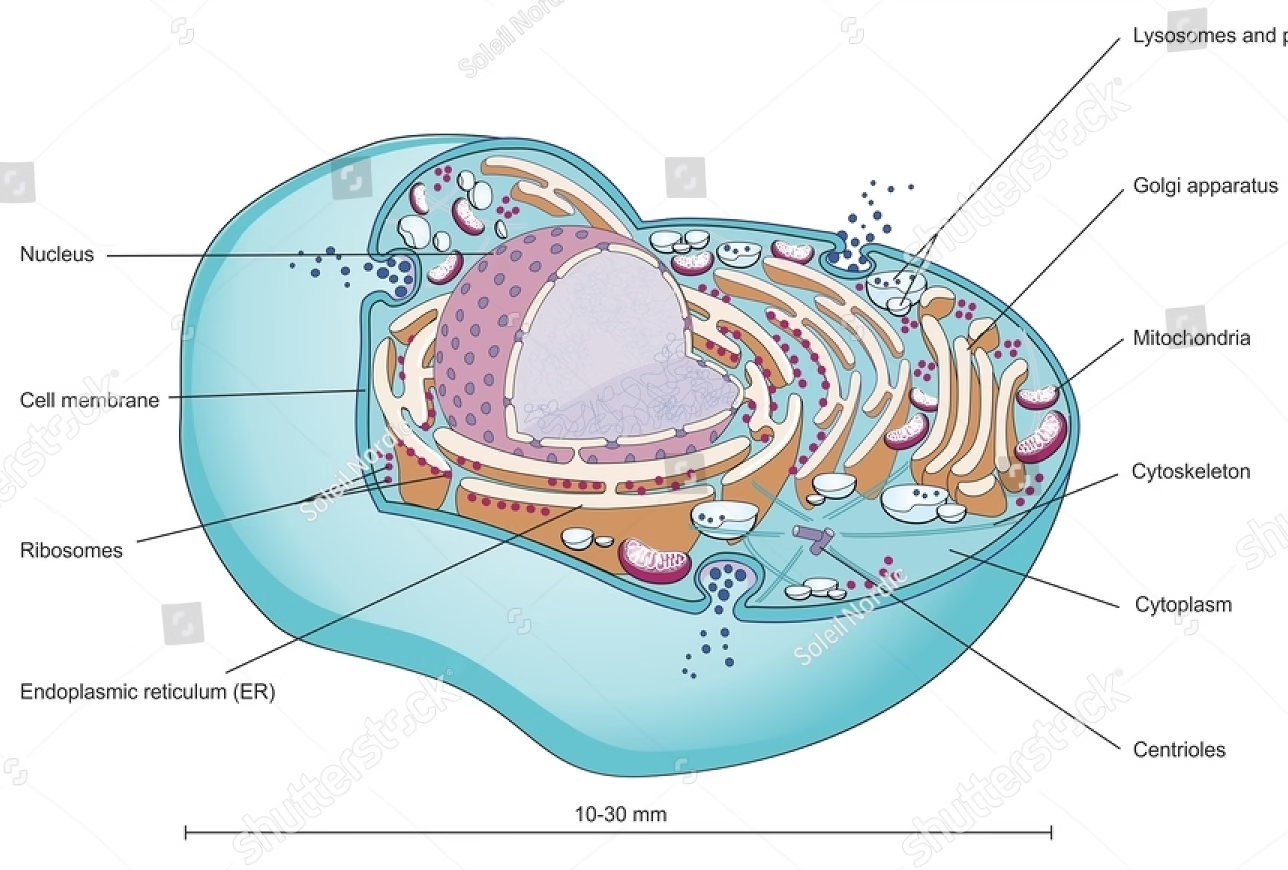Table of Contents
Introduction
Mammalian cells are the tiny powerhouses that comprise the tissues and organs of animals like humans, dogs, and whales. These microscopic structures are packed with fascinating features that keep living organisms alive and functioning. In this blog post, we’ll explore mammalian cells, how they work, and why they matter to science—all explained in simple terms!
What Are Mammalian Cells?
Mammalian cells are the basic structural and functional units of mammals. They are eukaryotic, meaning they have a well-defined nucleus and specialized compartments called organelles. These cells work together to carry out essential tasks like digestion, growth, and reproduction.
Key Features:
- Found in all mammals (including humans).
- Larger and more complex than bacterial or plant cells.
- Can specialize into different types (e.g., muscle cells, nerve cells).
The Structure of a Mammalian Cell
Think of a mammalian cell as a tiny factory with different departments. Here’s a breakdown of its main parts:
- Cell Membrane: The “security guard” of the cell. This thin layer controls what enters or exits the cell.
- Cytoplasm: A jelly-like fluid where organelles float.
- Nucleus: The “control center” holding DNA, which carries genetic instructions.
- Mitochondria: The “power plants” that generate energy (ATP).
- Ribosomes: Protein-making machines.
- Lysosomes: The “cleanup crew” that breaks down waste.

What Do Mammalian Cells Do?
Each organelle has a unique role:
- Energy Production: Mitochondria convert food into energy.
- Organelle: Mitochondria Function: Mitochondria, often called the “powerhouse of the cell,” convert nutrients from food into usable energy in the form of Adenosine Triphosphate (ATP).Process: This occurs through cellular respiration, where glucose and oxygen are broken down to release ATP.Importance: ATP fuels all cellular activities, including muscle contraction, nerve impulses, and chemical synthesis.
- Protein Synthesis: Ribosomes build proteins using DNA instructions from the nucleus.
- Organelle: Ribosomes
- Function: Ribosomes are responsible for building proteins, which are essential for nearly every function in the body, from enzyme production to muscle growth.
- Process:
- The nucleus contains DNA, which carries the genetic instructions.
- These instructions are transcribed into messenger RNA (mRNA).
- The ribosomes read the mRNA and assemble amino acids in the correct sequence to form proteins.
- Waste Removal: Lysosomes recycle old cell parts.
- Organelle: Lysosomes
- Function: Lysosomes act as the cell’s “recycling center,” breaking down and digesting old or damaged cell components.
- Process:
- They contain enzymes that digest proteins, lipids, and carbohydrates.
- Unusable waste products are expelled from the cell.
- Importance: This process prevents the accumulation of cellular debris, which could otherwise lead to cell dysfunction or diseases such as lysosomal storage disorders.
- Communication: Cells send signals to coordinate actions (e.g., healing a cut).
- Organelle: Cell Membrane & Signaling Molecules
- Function: Cells communicate with each other to coordinate functions like growth, repair, immune responses, and nerve signaling.
- Process:
- Cells send signals using chemical messengers such as hormones or neurotransmitters.
- The signals are received by receptors on the surface of target cells.
- This triggers a response, such as triggering an immune response or healing a wound.
- Example: When you cut yourself, skin cells send distress signals that attract immune cells to fight infection and start the healing process.
Specialized Cells:
- Red Blood Cells: Carry oxygen.
- Neurons: Transmit electrical signals in the brain.
- Skin Cells: Form a protective barrier.
Why Are Mammalian Cells Important in Research?
Mammalian cells play a crucial role in biomedical research, drug development, disease understanding, and biotechnology. Scientists study these cells because they closely resemble human cells, making them ideal models for testing and innovation. Research on mammalian cells has led to breakthroughs in medicine, including vaccines, cancer therapies, and tissue engineering.
1. Developing Medicines
- Purpose: Before new drugs can be used in humans, scientists must ensure they are safe and effective. Mammalian cells provide a controlled environment to test how drugs interact with cells before moving to animal or human trials.
- Process:
- Scientists grow human or animal cells in a lab.
- They expose the cells to experimental drugs.
- They observe how the cells respond—whether they survive, die, or change.
- Example:
- Cancer research: Drugs like chemotherapy agents are first tested on cancerous mammalian cells to see if they kill the tumor without harming healthy cells.
- Antibiotics & antivirals: Medications like remdesivir (used for COVID-19) were tested on lung cells to measure their effect on the virus.
- Importance: This process helps eliminate ineffective or harmful drugs before human trials, reducing risks and costs.
2. Understanding Diseases
- Purpose: Many diseases, such as cancer, Alzheimer’s, and diabetes, are caused by cellular dysfunction. Studying mammalian cells helps scientists discover:
- What goes wrong in the cells.
- How diseases progress over time.
- What treatments might stop or reverse the damage.
- Process:
- Scientists study diseased cells from patients or create genetic mutations in lab-grown cells.
- They analyze how the cells behave compared to healthy cells.
- They test potential treatments to see if the disease can be slowed or reversed.
- Example:
- Alzheimer’s Disease: Researchers study brain cells (neurons) from Alzheimer’s patients to understand why amyloid plaques build up, leading to memory loss.
- Diabetes: Scientists examine pancreatic beta cells, which produce insulin, to learn why they fail in diabetic patients.
- Importance: Understanding diseases at the cellular level allows scientists to develop targeted therapies rather than just treating symptoms.
3. Advancing Biotechnology
- Purpose: Scientists engineer mammalian cells to produce life-saving proteins, hormones, and even artificial organs.
- Process:
- Cells are genetically modified to produce useful substances.
- They are grown in large bioreactors to produce medicines on an industrial scale.
- Some are used in tissue engineering to create artificial skin, cartilage, or even whole organs.
- Example:
- Insulin Production: Before biotechnology, insulin was harvested from animal pancreases. Now, mammalian cells (such as CHO cells) are engineered to produce human insulin for diabetic patients.
- Monoclonal Antibodies: Mammalian cells are used to produce antibodies that help treat diseases like cancer and autoimmune disorders.
- Lab-Grown Organs: Scientists are developing lab-grown tissues for organ transplants, reducing the need for donor organs.
- Importance: Biotechnology makes medicine more effective, widely available, and personalized.
4. Example: COVID-19 Vaccine Development
- Why It Matters:
- The COVID-19 vaccines (such as Pfizer and Moderna’s mRNA vaccines) were tested on mammalian cells to ensure they triggered the right immune response before being given to humans.
- Process:
- Scientists grew human lung and immune cells in a lab.
- They exposed these cells to the vaccine to check if it produced the spike protein (which teaches the immune system to fight the virus).
- Once confirmed, the vaccine was tested on animals, then humans.
- Outcome: This research sped up vaccine approval and helped control the pandemic.
FAQs About Mammalian Cells
Q1: How are mammalian cells different from plant cells?
A: Mammalian cells lack cell walls and chloroplasts (used by plants for photosynthesis).
Q2: Why do scientists use mammalian cells instead of bacteria?
A: Mammalian cells are closer to human biology, making them better for medical research.
Q3: Can mammalian cells survive outside the body?
A: Yes! They’re grown in labs using nutrient-rich solutions (cell culture).
Q4: What happens if a cell’s organelles stop working?
A: The cell can malfunction, leading to diseases like mitochondrial disorders.
Keywords: #mammaliancells, #cellstructure, #cellfunctions, #organelles, #biotechnology, #eukaryotic #cells, #cellbiology.
More blogs click here

